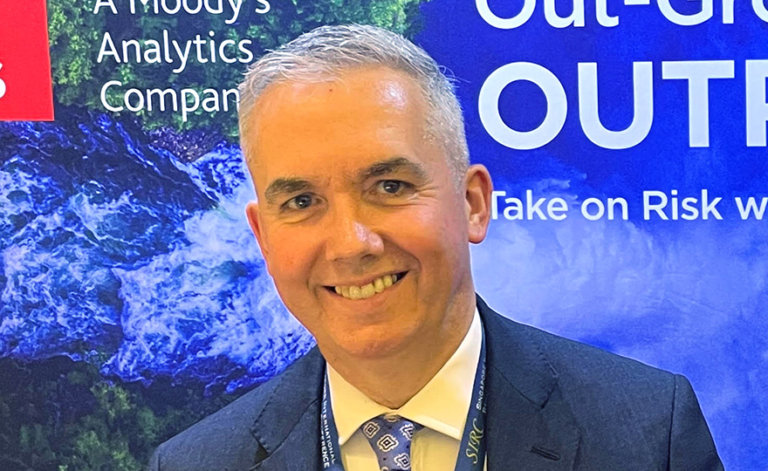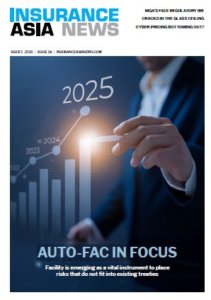RMS’ Michael Steel: ‘Committed to expanding APAC footprint in terms of models, perils and people’
November 7 2022 by Mithun Varkey
RMS, the Moody’s owned global catastrophe risk modeller, is looking to expand its footprint in Asia Pacific “in terms of models and perils” and “in terms of the people on the ground”, said Michael Steel, general manager.
“We are committed to the region. We’re committed to investing in the science. We’re committed to investing in the people and the teams on the ground. We really want to partner with our insurance company customers, the reinsurers and the brokers,” said Steel, who was appointed to the company’s global leadership position in April this year.
“We’re working on expanding our Australian model footprint. We’re working with the customers to really understand how we should be developing our road map going forward,” he said.
The company had launched inland flood models for China, New Zealand Thailand, Singapore, Malaysia and Indonesia, in the second half of 2021.
“We haven’t historically invested as much as we should in the region in terms of the model footprint, but when we brought out the South-East Asia flood models last year, it was a key differentiator for us. And the industry really stepped up and was really happy that they were seeing that level of investment from us,” he told InsuranceAsia News (IAN) on the sidelines of the Singapore International Reinsurance Conference (SIRC) last week.
Climate change
At the heart of catastrophe modelling is climate change and its impacts both in Asia and globally, especially in focus is what has come to be called secondary perils or non-modelled perils, which tend to have higher “climate change signature”. RMS invests about half of its revenue in R&D on new models and it has invested significantly on to deliver global flood models.
“When reinsurers look at underwriting, pricing, and aggregation they’re using the base case model as that we’re in a world of climate change and we need to think about that as they put it into their underwriting aggregation approaches,” Steel said. “If you look at the last five years of losses that we’ve seen across floods and wildfires and these so-called secondary perils as, they’ve contributed such a meaningful loss that reinsurers are modelling as if climate change is happening today, he said.
“At one point they were non-modelled perils, then we referred to them as secondary perils and now they have become the cause of material losses for the economies and for the insurance industry,” he noted.
“And particularly in this region [APAC], we launched our high definitions South-East Asia flood models which responded to that. In California and in Canada, a number of years ago, we launched wildfire models. I think we feel it’s incumbent on our role within the insurance market to really be investing in better data, better science to really help the industry understand those types of risks,” Steel said.
“I think what we’re seeing now is more immediate solutions on how to deliver new capacity for 1.1 renewals on a transaction-by-transaction basis, rather than sort of bringing in a new wave of four or five new reinsurers being started now.” Michael Steel, RMS
ILS in Asia
As we go into the 1.1 renewals, there is certainly a lot of concerns around the lack of retrocessional capacity, especially with ILS investors hit by Hurricane Ian in Florida.
“Hurricane Ian has caused a significant loss for the insurance industry and the ILS investors will play their role within that. There will be some trapped capital within it,” Steel said.
“Given we have obviously seen seeing the impact of Ian, and so we’re working at the moment with a lot of our broker partners on new types of solutions around parametric triggers around sort of other things to try to encourage new capital to come in and sort of on a new basis, to be able so we want to be part of that solution to bring new capital in,” he continued.
Steel though remains optimistic about Asian prospects.
“I think there is an appetite for Asian cat risk because it’s a diversifying risk for any ILS investor, any ILS portfolio, but it needs to be priced appropriately, it needs to be well understood, and that’s where the investment in the science really plays,” he said.
“We’re investing heavily in this region to really upgrade the quality of models so that we can open up that securitisation market much more,” he said.
“I think what we’re seeing now is more immediate solutions on how to deliver new capacity for 1.1 renewals on a transaction-by-transaction basis.”
However, investors seem to be slower in bringing new capital across markets, Steel said.
“I’ve been in the industry for over 30 years and have seen various cycles after 9/11 and after Katrina, we saw the new capital form and new companies. I’d say this time it feels slower than it than it has previously.”
There was more of an instant reaction previously with new startups starting like Ren Re after Hurricane Andrew and the whole class of 2008 after Katrina.
“I think what we’re seeing now is more immediate solutions on how to deliver new capacity for 1.1 renewals on a transaction-by-transaction basis, rather than sort of bringing in a new wave of four or five new reinsurers being started now,” he said.
Steel thinks a lot will depend on what happens at the 1.1 renewal season – whether rates rise significantly that suddenly business plans could work in this market.
However, he also added, “Hurricane happened very late in the season. It’s sort of at the end of September, so it’s very difficult to form a new company within a month or two and be ready for 1.1 renewals.”
“But I can certainly see that will have a number of new capital vehicles — maybe some new innovations that we haven’t seen before, maybe some new forms of capital. By the time we get into the June 1 and July 1 renewals, I think those sorts of vehicles will be up and running,” he said.
As part of the innovation, there are attempts afoot to create ILS bonds with new risks, such as cyber security threats.
“We are investigating, like others are, if could we securitise cyber risk,” he said. But he added that when working diversifying perils, it’s got to be priced appropriately and “the credibility of the models has got to be there”.
Cyber focus
RMS has been working on expanding its cyber risk capabilities, diversifying from its traditional strength of catastrophe modelling.
“We are working with the leading reinsurers and brokers in the cyberspace to help the insurance industry deal with how to think about cyber risk, how to underwrite it, how to manage it from a risk aggregation point of view.
“We’re now on our sixth version of our cyber model. It started off with purely trying to understand the aggregates. What sort of limits were available, and then we moved into simulation technology. And so we’re building out comprehensive datasets that help parameterise those types of models,” he added.
Steel pointed out that as part of Moody’s, which has been working with BitSight for a number of years to create cyber risk scores, the group has got two different approaches and that gives it the opportunity to look at what the next generation of models can be for the industry to help even better understand cyber risk.
“And to be able to create a common currency around cyber risk in the same way as we created a common currency around a property catastrophe risk,” he added.
ESG underwriting
The merger with Moody’s has helped the company broaden the scope of the offerings that it brings to the insurance industry now, he said.
“We have available a lot more data, assets and analytics offerings than we’ve ever had previously. Prior to RMS, Moody’s had a very light footprint within the P&C insurance space, and so we’re working together with our colleagues at Moody’s to bring all of those data and analytics offerings to the insurance industries through the same tools and through the same API’s as we deliver cat risk.
Moody’s has firmographic data on 450 million public and private companies and has ESG scores for these companies based on around 260 factors.
What RMS is looking at is how good a match it is to the types of risks that are being underwritten.
“If you can prove that your portfolio has a got a very high ESG rating it can attract capital that has got sustainable investing mandates.”
It is working with Chaucer as the lead to produce an ESG score on each of those risks within the portfolio and in aggregates to put an ESG score on the whole portfolio.
“Now what that does is that enables you to go to those individual cedents and say ESG score is very low in these categories because you’ve got all of the underlying data behind how it was made-up. You can work with that company to improve its ESG score,” he said.
This process can also help attract new types of capital to underwriting, noted Steel, “if you can prove that your portfolio has a got a very high ESG rating it can attract capital that has got sustainable investing mandates”.
Moreover, it could also help the underwriting process, he noted.
“In principle, if you’ve got strong governance in place, then you should have lower D&O losses. Similarly with lines of business like workers’ compensation, if you have good societal practices, then that should lead to lower workers’ compensation losses, and so we’re looking at the ESG scores and the correlations between different lines of business to be able to look at that and see if there are some signals there that we can build into the underwriting process so that you could underwrite a better portfolio,” Steel said.
-
Allianz General | Allianz General combines innovative protection solutions while powering social good to lead Malaysian market
The insurer proactively addresses emerging risks and evolving customer protection needs while giving back to the community.
-
Sedgwick | Asia’s Energy Transformation – Balancing Growth, Risk and Renewables
Energy market presents unique risks, especially in a region which includes China and Japan as well as developing nations like Vietnam and the Philippines.
-
Beazley | Turbulent Waters: the maritime energy transition challenge
Businesses are facing a complex transition to non-carbon energy sources amid a push to achieve net-zero emissions for the marine sector by 2050.
-
Aon | Navigating shifts in the global and Asia insurance markets
Neelay Patel, Aon head of growth for Asia, says the market in Asia is at an ‘interesting stage of the cycle’.

